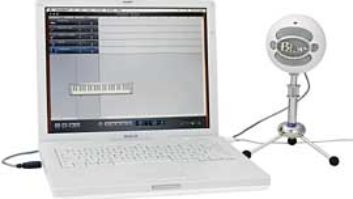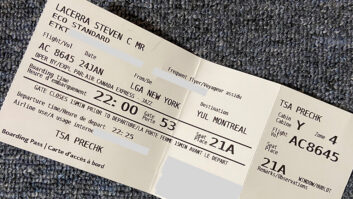You can’t really accuse Blue’s mics of blending into the
woodwork. Apart from being a 4-inch plastic sphere, The Ball is a
phantom-powered dynamic model. However, there’s no active
gain circuitry in this front-address cardioid mic; its output level is in the same
range as any other dynamic model, maybe 15 dB below a typical condenser. Instead, the phantom power is for a Class-A balancing circuit
that keeps the output impedance even across the mic’s specified
frequency range. Thus, the impedance controls we’re seeing on an
increasing number of new preamps should not have an effect.
The goal of The Ball’s active circuitry is to even out the
frequency response and create a smooth, open sound without giving up
the main advantages of a dynamic mic: ruggedness, some acoustic
compression, and distortion-free, high-SPL tolerance. (It’s
listed at 165 dB, which I didn’t test.) While the condenser mics
I compared The Ball to have more transient detail (and more low end),
it does achieve those aims to a fair degree. Blue specs a usable
frequency range of 35-16k Hz. The Ball has a bit of useful response at
35 Hz (about -25 dB down), but it rolls off rapidly starting at
approximately 100 Hz. Its most prominent region is roughly between 100
and 500 Hz, and the high end drops sharply starting at 4 kHz or so. I
didn’t notice any signs of life above 12 kHz.
This spherical mic can’t use a traditional clip or
shock-mount: A threaded swivel recessed on its bottom attaches it to a
mic stand. This design provides about 45° of up/down adjustment,
although I found the friction to be a little too light. The Ball
isn’t hypersensitive to shock noise, but there’s no obvious
way to avoid coupling it to the stand. [A shock-mount is planned for
release next month—Eds.] Like the rest of its line, Blue
assembles the mic in Latvia and build quality seems very good.
In general, The Ball is a mic for high-SPL usage. With a 17dB
A-weighted self-noise spec and a dynamic mic’s output level,
it’s not the first choice for distant-miking an orchestra. But
one of the things that the Ball does capture well is male vocals, both
sung and spoken. Its prominent lower midrange and smooth, round sound
in that region, along with the natural acoustic compression, combine
very nicely.
Its low-frequency roll-off has a side benefit: You can often get by
without using a pop filter. This would also be a good mic for a female
singer who really belts it out. The Ball worked especially well on a
hard-strummed acoustic guitar. Here, again, the smooth midrange and
acoustic compression created a natural sound that sits nicely, with
just enough detail not to sound constrained. The mic was also nice on
wooden percussion—claves, castanets, etc.—and hand claps
and finger snaps.
For $199, it’s hard to go wrong with The Ball. It’s a
role-player, but one that can play many parts.
Blue Microphones, www.bluemic.com






